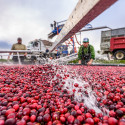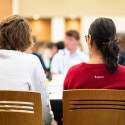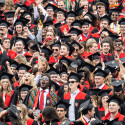Mentor award winners guide, inspire undergraduates
Each spring the Office of the Provost recognizes outstanding mentors with the Awards for Mentoring Undergraduates in Research, Scholarly and Creative Activities.
The nominations for this year’s recipients read like a textbook of great mentoring practices — meeting students where they’re at, getting to know them as scholars and individuals and guiding their learning with just the right mix of challenge and support. Learn more about these awards — 2026 nominations will open this fall.
Aaron Dingle
Senior Research Scientist, Surgery

Aaron Dingle checks in with students working on microscope assembly — from left, Jusuf Ademi, Natalie Furtado and Sarah Hu — in the Microsurgery and Regenerative Medicine Laboratory in the Wisconsin Institutes for Medical Research. Photo: Althea Dotzour
Students mentored by Aaron Dingle have an unusual opportunity to learn while making an impact across the world. Dingle co-directs the Microsurgery and Regenerative Medicine Laboratory. His students not only learn how to perform microsurgery, but they also manufacture and assemble microscopes used for microsurgery that are sent overseas to clinics that otherwise would not have access to such equipment. Many students also have the opportunity to publish their research – in 2024 alone, five of Dingle’s 11 publications included undergraduates as co-authors, with three as the first author.
“The moment my manuscript was published was one of the proudest moments of my life, made possible by his unwavering support and belief in my abilities,” says Maci Fulton, who joined the lab as a summer intern. “What truly sets Dr. Dingle apart is his remarkable ability to see potential in me before I could see it in myself. … He has shaped me into a better scholar, a more confident individual and someone who aspires to carry forward the same spirit of mentorship he has so generously shared.”
Linda Horianopoulos
Postdoctoral Fellow, Wisconsin Energy Institute
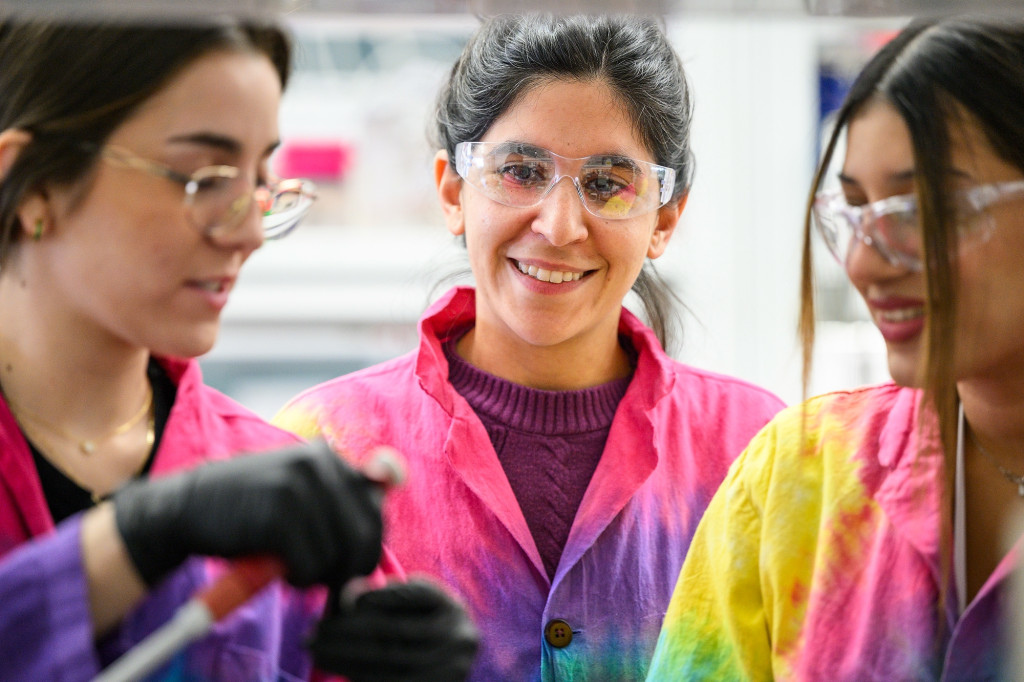
Linda Horianopoulos works with mentees Devlyn Zeng, left, and Lamar Hakami, in the Hittinger Lab in the Wisconsin Energy Institute. Photo: Althea Dotzour
Linda Horianopoulos “has a real knack for intuiting where a student is intellectually and experientially, meeting them there and then helping them design the perfect project for them,” says Professor Chris Hittinger. This can yield extraordinary results. When undergraduate Katarina Aranguiz suggested using machine learning for a project, Horianopoulos had no experience with the coding language involved but gave the go-ahead and had Aranguiz teach her the coding. The result: a massive amount of new data on the diverse yeast species that the lab studies as part of its work to improve biofuel production and combat climate change.
“Aside from the technical and problem-solving skills Linda has taught me, I’ve learned that the best mentors are capable of listening to and learning from their mentees,” says Aranguiz. “I’ve learned to believe in myself and never give up because of Linda’s positivity, and I aim to pursue a career in research because of what Linda has shown me.”
Randall Kimple
Professor, Human Oncology
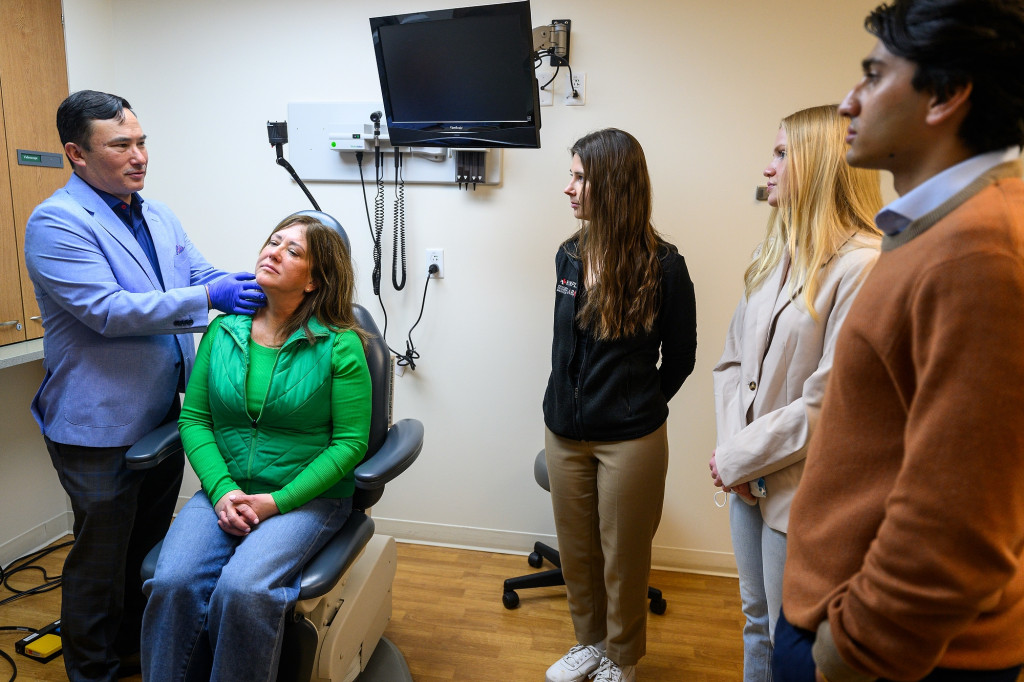
Randall Kimple examines patient Lisa Sutter as mentees Rachel Minne, Madalynn Wopat and Saahil Javeri observe. Photo: Althea Dotzour
Randall Kimple is both a researcher and a physician. In the lab, he works with undergraduates on cellular therapies to reverse radiation-induced damage to the salivary glands in patients with head and neck cancers. He also wants students to see cancer from the patient’s perspective, so he invites them into the clinic as he cares for patients. Many of his mentees are inspired to pursue careers in medicine and science, and Kimple guides them in acquiring the experiences that will help them be standout candidates.
“He spent countless hours helping me prepare scholarship applications, refine my research presentations and develop my scientific writing skills,” says mentee Qianyun (Lexi) Luo. “His investment in my success went far beyond what was required of a research mentor, showing a genuine commitment to developing the next generation of physician-scientists.” (Luo went on to receive the prestigious Goldwater and Astronaut scholarships, was a finalist for the Rhodes Scholarship and is now pursuing an MD/PhD at the University of Minnesota.)
Katie Klimpel
Graduate student, Genetics
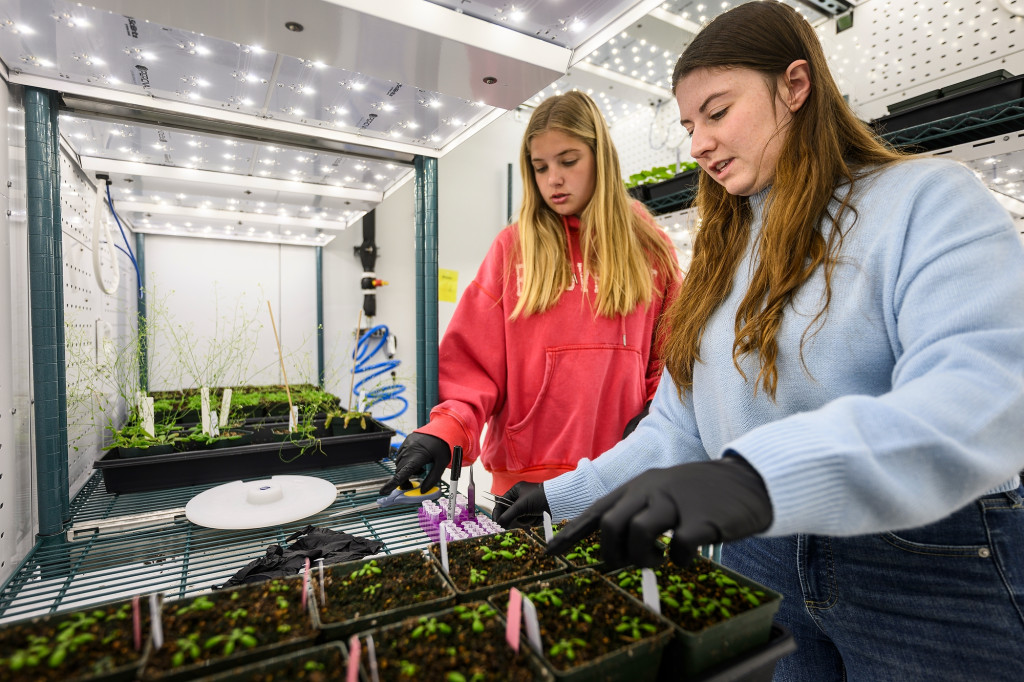
Katie Klimpel, at right, is shown with mentee Allison Karnitz in a growth chamber in the Brunkard Lab in the Genetics & Biotechnology Center. Photo: Althea Dotzour
Katie Klimpel mentors undergraduates in research on how cells monitor nutrient availability, hoping to better understand the growth of important food crops such as tomato, corn, wheat and rice. Her own mentor, Professor Jacob Brunkard, calls her achievements incredible: “She independently initiated three completely new research projects in the lab, has mentored 18 (!) undergraduate researchers and 6 PhD rotation students with stellar outcomes, has started new outreach programs for the lab, has presented at four international conferences and many national/regional/local conferences and has authored five publications currently in revision (including three as first author).” For undergraduate Kyle Koch, Klimpel’s mentoring approach helped what could have been a challenging transition go smoothly. Koch returned to UW–Madison after spending a decade as a farmer.
“Katie’s mentorship balances an easy-going manner with scientific rigor, which helped me to develop quickly as a beginning scientist, and soon the lab felt like a second home,” Koch says. “People like Katie, who care deeply about both the wellbeing of the students and the quality of the science, are a significant part of what makes undergraduate research at UW–Madison so special.” (Koch is now pursuing a PhD in plant and microbial biosciences at Washington University.)
Emma Libersky
Graduate student, Communication Sciences & Disorders
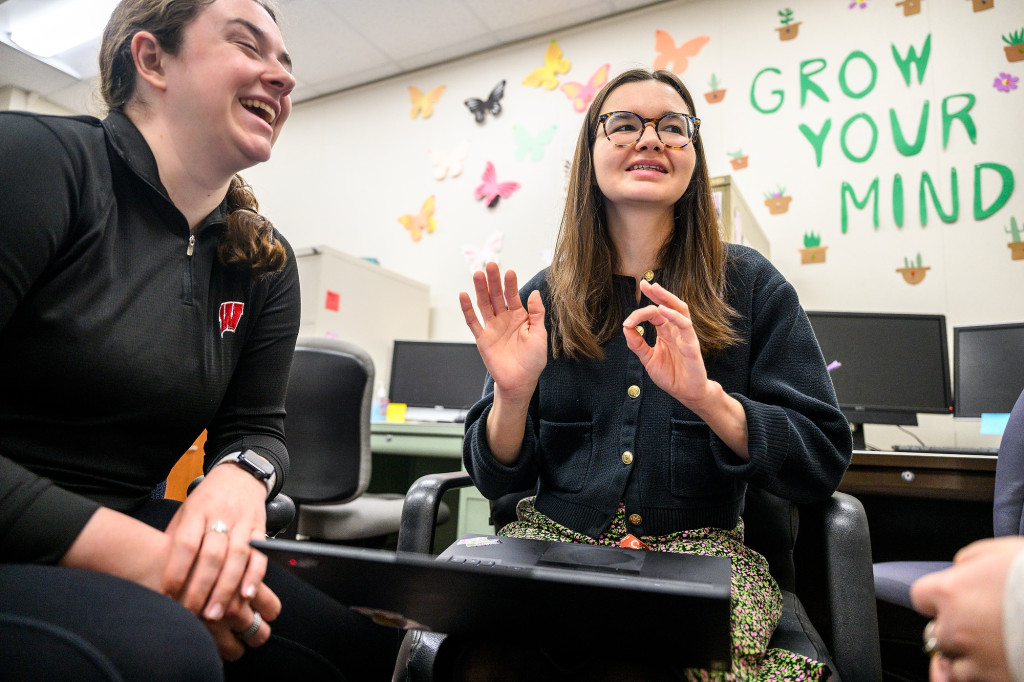
Emma Libersky, center, talks with mentees Maggie Thomas, left, and Grace Whelan Tweedt, right, in the Language Acquisition and Bilingualism lab in the Waisman Center. Photo: Althea Dotzour
Many students say that Emma Libersky was the first graduate student to come over and say hello when they started working in the Language Acquisition & Bilingualism Lab. Those first introductions blossom into deep relationships lasting throughout students’ time at UW–Madison and beyond. Libersky guides students in researching how children learn language and develop intellectually, with an emphasis on understanding both typically developing children and those with autism and other conditions. Many of her mentees aspire to become speech-language pathologists or go to graduate school, and Libersky offers professional development sessions to coach them on career paths and navigating the graduate school application process.
“Emma has created an atmosphere in the lab where undergraduates feel comfortable and empowered to collaborate with graduate students,” say students Maggie Thomas and Madeline Hauenstein. “Her approachability, willingness to listen to, and desire to incorporate our insights make us feel respected and valued.”
David Lovelace
Museum Scientist, Geoscience
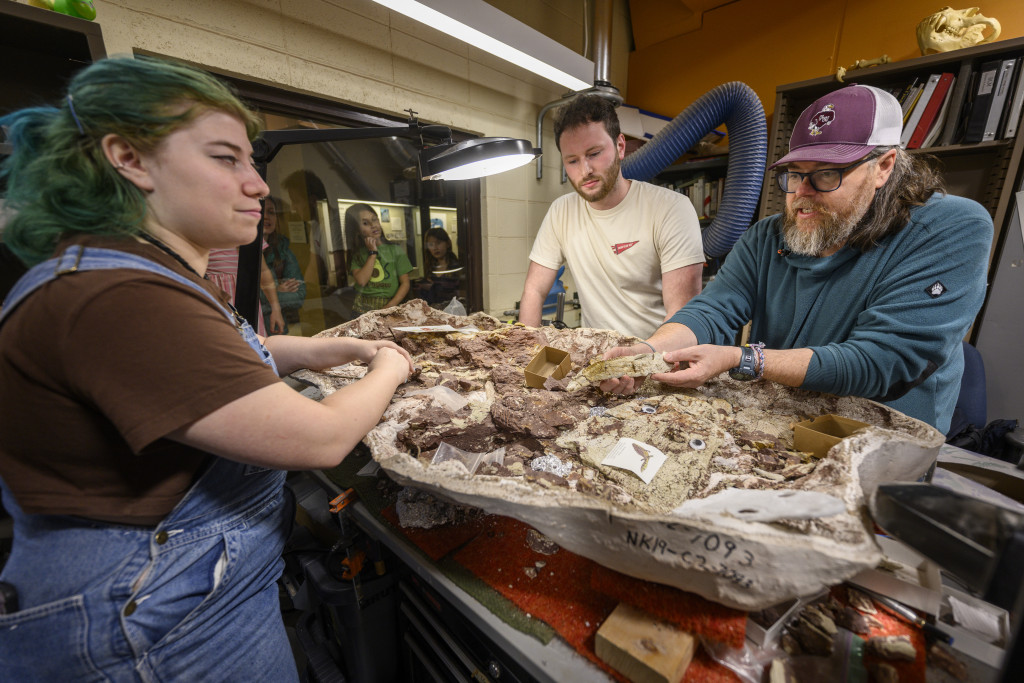
At right, David Lovelace works with Matildé Acosta, left, and Jack Gardner, center, as they remove sediment from a fossil in plaster cast in the Geology Museum’s specimen preparation room in Weeks Hall. Photo: Althea Dotzour
David Lovelace involves students in the full spectrum of his paleontological research on amphibians, dinosaurs and their closest croc-line relatives, and the ecosystems they were part of 230 million years ago. This work takes place in the Geology Museum’s Fossil Preparation Lab and in the rugged backcountry of Wyoming, where students often join field expeditions. On those trips, they learn how to excavate fossils and interpret rock layers as well as deal with challenges like back-to-back flat tires and 70 mph winds. Several of the fossil sites are near the Wind River Reservation, home to the Eastern Shoshone and Northern Arapaho tribes. Lovelace has forged a partnership with these communities that has led to the naming of three extinct species in Shoshone and Arapaho. Lovelace’s undergraduate mentees are also helping the area’s high school students prepare and exhibit 230-million-year old fossils that were repatriated to their tribal lands after being illegally collected by another institution. This spring, Lovelace welcomed a group of middle and high school students from Wyoming’s Fort Washakie Schools to Madison.
“I had the privilege of visiting the reservation with another undergraduate, where I heard firsthand from community members about Dave’s unwavering respect for tribal voices,” says student Matildé Acosta. “He has worked tirelessly to honor Indigenous perspectives in an often-archaic field, earning the admiration of students and professionals alike.”
Mayra Oyola-Merced
Assistant Professor, Atmospheric & Oceanic Sciences
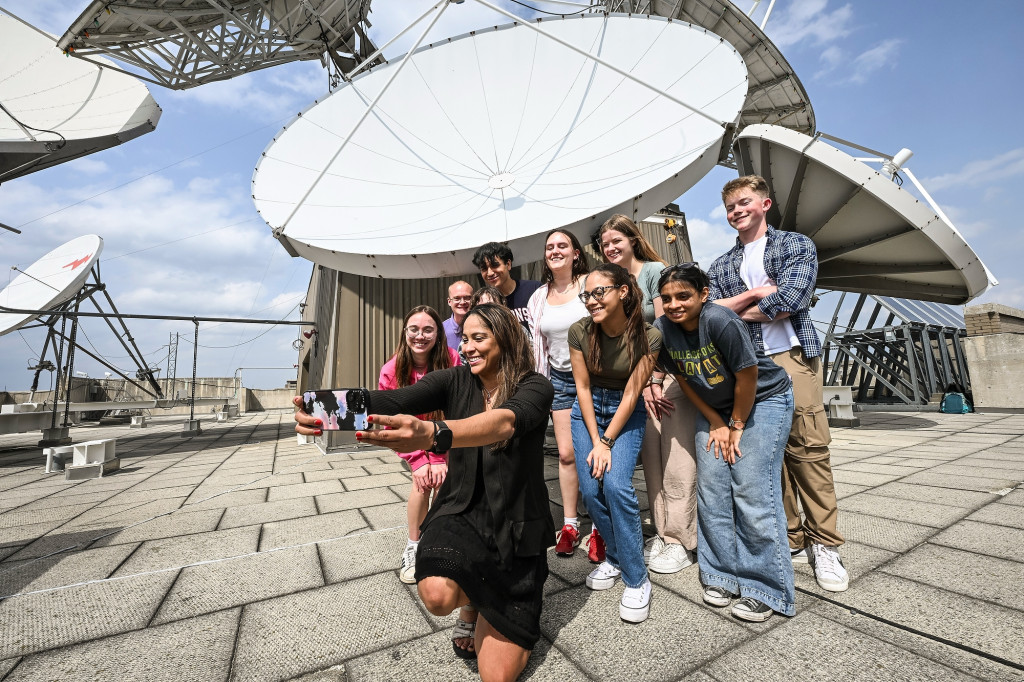
Mayra Oyola-Merced takes a selfie with a group of students next to weather observation equipment on the top of the Atmospheric, Oceanic and Space Science Building. Photo: Althea Dotzour
From her first semester on campus, Mayra Oyola-Merced made it a priority to engage with undergraduates, despite the many competing demands on her time as an early-career faculty member researching how to improve space-borne observation for predicting severe weather and air quality. Not only is she a caring, dedicated mentor to the undergraduates in her research group, she informally advises many more and is one of the first faculty members students get to know, says department chair Ankur Desai. Oyola-Merced is particularly adept at mentoring the growing number of AOS students from backgrounds that have historically been underrepresented in the field — she is herself an underrepresented scholar and a graduate of minority-serving institutions who worked at NASA’s Jet Propulsion Laboratory before coming to UW–Madison. When student Paige Bartels confided that she was having trouble finding a summer research internship, Oyola-Merced took her on. By the end of her first year, Bartels had conducted meaningful research, presented at a national conference and landed a scholarship.
“I have never felt more supported and valued at this university than through the love and guidance I have felt from Dr. Oyola-Merced,” she says. (Bartels graduated this month and credits her mentor for helping her land funded offers from two prestigious PhD programs.)
Hyewon Park
STEM Advisor, Center for Educational Opportunity

Hyewon Park, right, talks with student and mentee Kevin Phalphouvong during the Undergraduate Symposium, where Phalphouvong presented his work, in Union South on April 25. Photo: Althea Dotzour
More than 90 percent of the students served by the Center for Educational Opportunity (CeO) are the first in their families to go to college. Many are pursuing ambitious dreams of becoming nurses, doctors, engineers and researchers, and they face steep challenges beyond just earning their degrees. The STEM path they’ve chosen demands that they navigate an unfamiliar landscape, building skills, tools and experiences from the ground up. Hyewon Park doesn’t just open doors for these students, her colleagues say, she empowers them to walk through them. Recognizing that participation in research is critical to success after graduation, Park created a weekly pre-health/research club and cultivates relationships with researchers on and off campus to find opportunities for her students. She also helps students gain practical life skills. Max Berumen says that through Park’s financial literacy club, he became much more adept and confident managing his money — so much so that Park persuaded him to present on the topic at a national conference.
“If the CeO program retired jerseys like professional sports teams, Hyewon would be the first one with her number up there,” Berumen says.
Marla Ramírez
Assistant Professor, History and Chican@ & Latin@ Studies
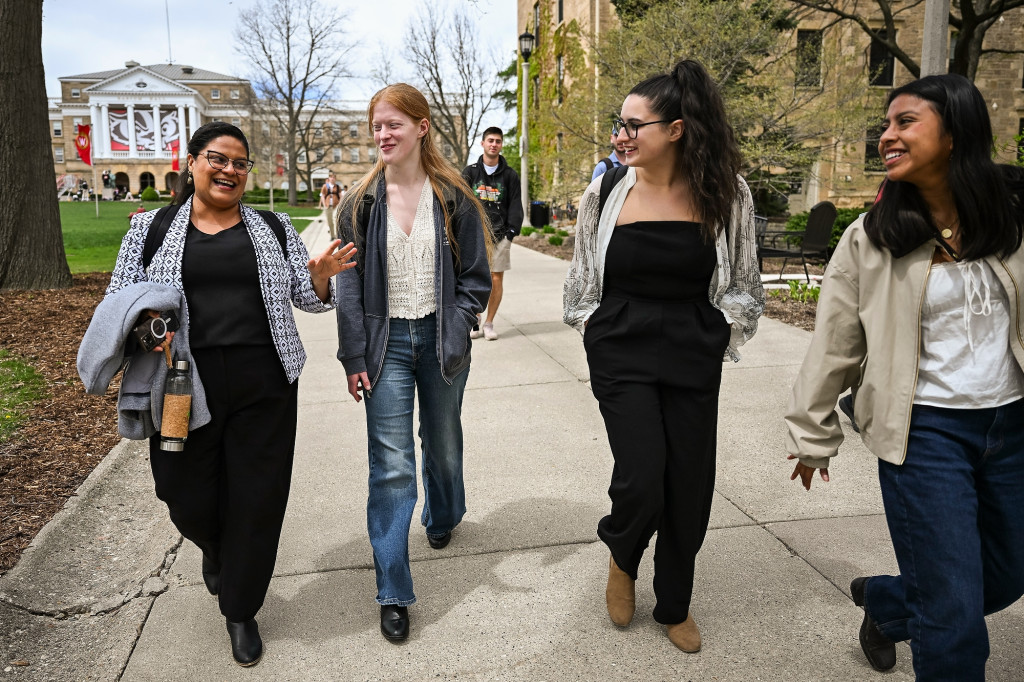
Marla Ramírez, left, walks down Bascom Hill and chats with students, left to right, McKenna Grau, Elise Rouleau-Rivera and Ana Celeste Shriver. Photo: Althea Dotzour
Marla Ramírez takes an innovative approach to mentoring that blends teaching, community engagement, and professional-level research opportunities for undergraduates. In 2019, she collaborated with three other UW–Madison faculty to create the Wisconsin Latinx History Collective to document the stories of Latinx communities in Wisconsin. Since then, the collective has grown to a state-wide collaboration composed of faculty, students, and community members across the state and beyond. She has trained more than 300 students in her classes to conduct oral history interviews, which will become part of a new collection at the Wisconsin Historical Society. Ramírez also involves undergraduates as research assistants in her ongoing scholarship, including her forthcoming book, Banished Citizens: A History of the Mexican American Women Who Endured Repatriation (Harvard University Press, October 14, 2025), which documents the transgenerational effects of the mass removals during the interwar period (1921–1944) that banished thousands of working-class US-citizen women and children as a strategy to expel entire mixed-status ethnic Mexican families and prevent return migration. Student Lezly Vejar worked on both projects, presented her oral history work at a national conference, and now plans to pursue a PhD.
“You gave me the courage I needed to stand up and speak about the work I had become so passionate and proud of,” Vejar wrote to Ramírez. “As a first-generation Mexican scholar, you understand my struggles and obstacles as well as my need to juggle my family obligations, work and academic responsibilities. … I cannot thank you enough for instilling a newfound passion and believing in me.”
Kumar Sridharan
Grainger Professor and Vilas Distinguished Achievement Professor, Materials Science & Engineering and Nuclear Engineering & Engineering Physics
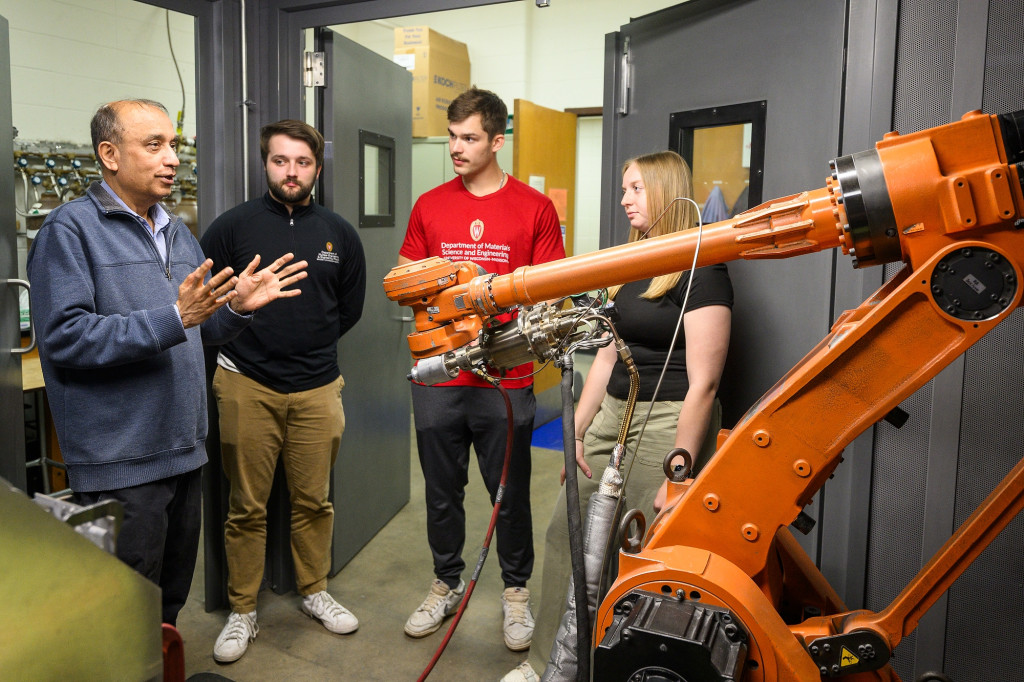
Kumar Sridharan speaks with students, from left, Thomas Demo, Michal Zylka and Laney Zuelsdorff in the cold spray lab, where equipment sprays powders at supersonic velocities. Photo: Althea Dotzour
For more than 30 years, Kumar Sridharan has welcomed undergraduates into his lab, the Nuclear and Applied Materials Research Group. He devotes the time and funds to train them to become independent users of sophisticated scientific instruments that undergraduates don’t normally get to touch. Many become co-authors on scientific publications; one current student is credited on two patents. Because of the size of Sridharan’s research group and his dedication to undergraduate education, student Kelsey Amundson was able to do research with a wide range of applications, including stress corrosion cracking in nuclear waste storage, radiation damage in fusion and fission systems and accident-tolerant fuels. Her first job after graduation was with the Defense Nuclear Facilities Safety Board, and she’s now a research and development engineer with Los Alamos National Laboratory. Many of Sridharan’s mentees have gone on to leadership positions in industry, academia and national laboratories. Dan Gianola credits Sridharan’s inspiration, patience and infectious curiosity with starting him on the path to becoming a materials professor with a research group of his own at the University of California, Santa Barbara.
“His balanced guiding hand providing both independence (and letting me wrestle with fun and challenging problems) and support is something I try to model in my own role, even though I aspire to meet Professor Sridharan’s example,” Gianola says. “I am so appreciative of the chance that Professor Sridharan took on me as a young, naive undergraduate student, and I’m certain that my story is one of many who were also inspired by him.”

